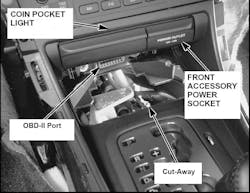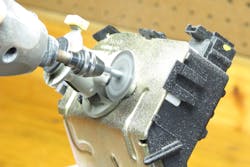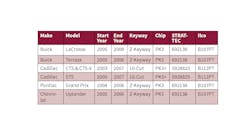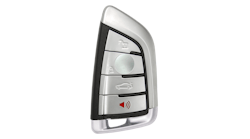Exceptions In Automotive Locksmithing
From 1988 until 2013, I traveled all over the United States teaching automotive locksmithing. I taught thousands of locksmiths, and one of the things that I stressed at the beginning of most of my classes was “There is always an exception.”
Yes, after you understand the Ford eight-cut system, you can deal with just about any Ford eight-cut lock … until you try to service the trunk lock on a Ford Focus made between 2000 and 2003. Or you might believe that you know that on all OEM Ford remote head keys (RHK), the remote will program at the same time as the key, until you run into a late-model Fiesta that uses an RHK.
These exceptions are what make automotive locksmithing interesting, at least to me. But when you encounter some of these things unprepared on a busy day, it can be like having a blowout on the interstate during rush hour. Your day suddenly will go from organized and productive to utter chaos. In this article, I plan to shine a little light on some of these exceptions so you can take them in stride.
Ford Fiesta RHK
A lot of the current version of the Ford Fiestas sold in the United States (Image 1) use a proximity fob. Programming an extra fob or replacing a lost fob in an all-keys-lost situation is pretty much the same as on any other Ford vehicle. The biggest challenge is to figure out where they hid the programming slot. On the Fiesta, even that’s a little strange, but a quick look at the owner’s manual solves that problem. Just in case you’re curious, it isn’t really a slot, but just an indentation on the side of the steering column shroud where you must hold the fob during programming. (Image 2)
When you program an RHK, all of the normal rules apply except that the remote portion of the key must be programmed through an on-board procedure, rather than programmed automatically along with the key. This wouldn’t be much of an irritation if the Fiesta used the standard on-board procedure, but, naturally, it doesn’t.
For all I know, this might be a common procedure on Ford vehicles sold in other countries, but as far as I know, the Fiesta is the only Ford vehicle sold in the United States that uses the procedure, listed below. The really strange thing about this procedure is that the remote programs after you take the key out of the ignition!
Step 1: After programming all the transponder keys that are necessary to start the car, sit in the driver’s seat with the door open.
Step 2: Insert any key into the ignition and cycle the ignition from “OFF” to “ON” three times. Then turn the ignition to the “OFF” position and remove the key.
Step 3: As soon as the key is removed from the ignition, the door locks should cycle to indicate that the vehicle is in the programming mode. If the door locks don’t cycle, repeat the above procedure. (I have been told that some vehicles require eight cycles before going into programming mode.)
Step 4: As soon as the door locks cycle, press any button on the new key, and the locks should cycle again to indicate that the new key has been accepted. If you have additional keys to program, press any button on each key in turn to program all keys. After all keys have been programmed, insert any key into the ignition and turn it “ON” to exit the programming mode.
This procedure will erase all previously programmed remotes, so if the owner has a working key, it will have to be relearned at the same time as the new key.
When I ran into one of these cars at a dealership recently, the car had two working keys, but only one had a remote that worked. As it turned out, both keys were in good working order, but the second key, an aftermarket or reshelled key that had no logo, never had been programmed. Apparently, someone couldn’t figure out how to program the remote.
I started by cutting and programming a new key, after assuming that there was a problem with the key that had the nonworking remote. But my new key did the same thing as the existing key. Then, I was off on a wild goose chase to find the correct programming procedure. All of the internet searches that I tried just gave me the standard Ford eight-cycle routine. After several calls to some friends, I finally got the correct information (thanks to Randy Mize). I soon had three fully functional working keys for the vehicle!
I still am not certain whether all the current production Ford Fiestas use this procedure, but all require onboard programming of the remote.
Honda and Acura OBD Port
For some reason, the engineers at Honda seemed to believe that they should hide the position of the OBD-II port on many of their Honda and Acura vehicles made in the early 2000s. In most cases, it isn’t too difficult to locate the port. It often is positioned far to the right under the lip of the dash pointing down, or sometimes toward the front of the vehicle, so you either have to get your head completely under the dash or use a mirror to see it.
But on one vehicle in particular, the Acura TL made from 1999 to 2003 (Image 3), the Honda engineers really outdid themselves. The OBD port is in the forward part of the center console, behind an unlabeled plastic panel, and sometimes an ashtray is mounted in the same area that must be removed to access the OBD port. (Image 4) When you find the port, you often also will find some loose change, cigarette butts or petrified french fries along with it!
Ford Focus Trunk
You might have made keys to the trunk locks on the Ford Focus from 2000 to 2003 and never had any problem. The problem comes if the lock has failed or if you have to rekey it. The power trunk latch mechanism and the lock cylinder are integrated into one device, and, at first glance, there appears to be no way to separate the lock cylinder from the electronic portion. In fact, I poked around on one of these things for several days before I threw in the towel and resorted to an online resource to find out how to take it apart.
The first thing you have to keep in mind is that this lock was made by Hurd, and as with most of the locks that it made, the Focus trunk lock never was intended to be serviced. But even though the lock wasn’t designed to be serviced, just like the Ford 10-cut locks that Hurd made, it still is possible to service the lock. It just isn’t easy, and no parts are available.
The problem is Hurd didn’t provide a poke hole to access the pin. But after you realize where the pin is located, it’s easy to use a Dremel tool that has a cut-off wheel to remove the top of the pin chamber. That will expose the spring that you then can remove. Then you can turn the lock over so the pin disengages from the electronic module, and then you can remove the lock cylinder.
Unfortunately, that’s difficult to photograph, so in the images, you’ll see me use a magnet to pull the pin up and remove the cylinder. If you plan to reuse the cylinder, you can add threads to the inside of the pin chamber and then thread a bolt into place to lock everything down. I chose to cut off the bolt and then use a punch to stake the remains of the bolt into place so it wouldn’t unscrew accidentally. (Images 5–9)
Ford Mustang Trunk
This next one technically isn’t an exception. It’s more of a cool technique that works because of an odd feature of the design on the Ford Mustang trunk from 2005 to 2010.
When this version of the Mustang was introduced, the designers didn’t equip the vehicle with an inside trunk release. The trunk lock was recessed into the Mustang logo trim, which made the lock difficult to pick. The remote could unlock the trunk, so the vehicle had an electronic trunk release, but there just was no button inside the vehicle to activate it. When an owner locked the keys in the trunk, it was a difficult opening.
I discovered a simple way to activate the electronic trunk release from under the hood. The trunk release relay is located in a fuse box under the hood, and after you unplug the trunk release relay, you can use a paper clip or something similar to short out two terminals and activate the trunk release as long as the vehicle has power. (Images 10–13)
Oddball Transponder Keys
A lot of time and money gets wasted every year by locksmiths who assume that a vehicle uses the same transponder key as other vehicles made by the same manufacturer in that same year. The irregularities will trip you up if you aren’t careful. I knew a guy who wasted seven tokens on his MVP, as well as seven key blanks, trying to program a Chrysler vehicle with the wrong key! (He incorrectly assumed that the keys that he wasted had defective chips.) Most of this wasted time and money could be avoided simply by checking key-blank references, but we all make the mistake of assuming things from time to time.
The ones that get me most often are the 2000–2005 Ford Focus, the 2001–2004 Ford Escape and the 2000–2006 Lincoln LS. These vehicles use the standard H-75 keyway but are equipped with an oddball “encrypted” transponder that only was used for the years listed.
If you look up those three vehicles, you’ll see that two of them take the H-86PT key, while the Lincoln LS uses the H-74PT key. Both keys use the same chip, but the H-74PT is slightly longer to accommodate the in-dash ignition of the Lincoln LS. The difference in length is small, but the H-86PT is too short to work on the Lincoln LS. The H-74PT will work on all three, which is why that’s the blank that I stock.
The Z-Keyway
In summary, there always are exceptions to every automotive locksmithing rule, and the quickest way that I know to waste time and money in this business is to assume that you know it all. This might be the one area where the codesmiths outflank locksmiths, because they have to look up everything! Take a few seconds before you dive into a job to verify that what you know is actually correct.
Steve Young has been a locksmith since 1973 and has trained and taught locksmiths since 1988. He is a frequent contributor to LocksmithLedger.











